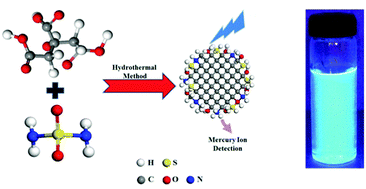Synthesis, mechanistic investigation, and application of photoluminescent sulfur and nitrogen co-doped carbon dots†
Abstract
Heteroatom doped carbon dots (CDs) with consummate photoluminescence quantum yield (PLQY) are of great interest in various applications such as trace element detection, biomolecule markers, and chemical sensing. However, due to the low doping efficiency of the reaction, a high precursor ratio is routinely used to obtain CDs with considerable photoluminescence quantum yield (PLQY). In this contribution, we report a single-step hydrothermal method having the highest doping efficiency to synthesize sulfur and nitrogen co-doped semi-crystalline carbon dots (S,N-CDs) with superior quantum yield (QY). Here, the unprecedented doping efficiency of the reaction enables an order of magnitude reduction in the starting precursor ratio, in comparison with previous reports. Moreover, for the first time, complementary theoretical and comprehensive spectroscopic techniques were employed to derive deep insight into the photoluminescence mechanism and the shifting of specific energy levels in doped CDs was identified as the reason behind the enhanced photoluminescence of doped CDs. The PLQY and luminescent characteristics of the S,N-CDs can be tuned by controlling the precursor molar ratio, the extent of surface oxidation, and chemical status of S in the CDs. While most methods report high PLQY for amorphous CDs, our technique produces semi-crystalline CDs with more than 55% QY. Another unique attribute of the S,N-CDs is the high monodispersity and defined surface chemistry and the resultant highly robust excitation-independent luminescence that is stable over a broad range of pH values and in an extremely reactive environment. The detailed structural and chemical investigations using spectroscopic and microscopic techniques combining molecular simulation revealed that the superior PLQY and luminescence of S,N-CDs are due to the heteroatom directed, oxidized carbon-based surface passivation. The remarkable, robust fluorescence properties of S,N-CDs were applied for the ultra-trace detection of Hg2+ with a detection limit of 100 pM. The novel insights into the photoluminescence of doped CDs, the robust luminescence, and enhanced doping reaction efficiency reported here are envisaged to drive transformative changes in the design of CDs with peerless properties for futuristic applications.


 Please wait while we load your content...
Please wait while we load your content...